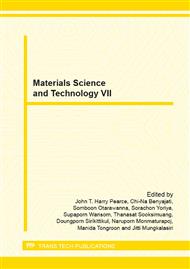[1]
T. Iwata, Characterization of Ni-YSZ anode degradation for substrate-type solid oxide fuel cells, J. Electrochem. Soc. 143 (1996) 1521-1525.
DOI: 10.1149/1.1836673
Google Scholar
[2]
A. Naoumidis, A. Tsoga, P. Nikolopoulos, H. Grübmeier, in: M. Dokiya, O. Yamamoto, H. Tagawa, S.C. Singhal (Eds.), Proc. 4th Int. Symp. Solid Oxide Fuel Cells (SOFC-IV), The Electrochemical Society, Pennington, NJ, 1995, p.667.
Google Scholar
[3]
H. Itoh, T. Yamamoto, M. Mori, Configurational and electrical behavior of Ni-YSZ cermet with novel microstructure for solid oxide fuel cell anodes, J. Electrochem. Soc. 144 (1997) 641-646.
DOI: 10.1149/1.1837460
Google Scholar
[4]
A. Ioselevich, A.A. Kornyshev, W. Lehnert, Degradation of solid oxide fuel cell anodes due to sintering of metal particles, J. Electrochem Soc. 144 (1997) 3010-3019.
DOI: 10.1149/1.1837952
Google Scholar
[5]
D. Simwonis, F. Tietz, H. Tagawa, Nickel coarsening in annealed Ni/8YSZ anode substrates for solid oxide fuel cells, Solid State Ionics 132 (2000) 241-251.
DOI: 10.1016/s0167-2738(00)00650-0
Google Scholar
[6]
Z. Jiao, N. Takagi, N. Shikazono, N. Kasagi, Study on local morphological changes of nickel in solid oxide fuel cell anode using porous Ni pellet electrode, J. Power Sources 196 (2011) 1019-1029.
DOI: 10.1016/j.jpowsour.2010.08.047
Google Scholar
[7]
M.H. Pihlatie, A. Kaiser, M. Mogensen, M. Chen, Electrical conductivity of Ni-YSZ composites: Degradation due to Ni particle growth, Solid State Ionics 189 (2011) 82-90.
DOI: 10.1016/j.ssi.2011.02.001
Google Scholar
[8]
H. Kishimoto, A. Suzuki, T. Shimonosono, M.E. Brito, K. Yamaji, T. Horita, F. Munakata, H. Yokokawa, Agglomeration behavior of nickel particles on YSZ and TiO2-doped YSZ electrolytes, J. Power Soursces 199 (2012) 174-178.
DOI: 10.1016/j.jpowsour.2011.10.047
Google Scholar
[9]
C.M. Grgicak, M.M. Pakulska, J.S. O'Brien, J.B. Giorgi, Synergistic effects of Ni1-xCox-YSZ and Ni1-xCux-YSZ alloyed cermet SOFC anodes for oxidation of hydrogen and methane fuels containing H2S, J. Power sources 183 (2008) 26-33.
DOI: 10.1016/j.jpowsour.2008.05.002
Google Scholar
[10]
T. Ishihara, J. Yan, M. Shinagawa, H. Matsumoto, Ni–Fe bimetallic anode as an active anode for intermediate temperature SOFC using LaGaO3 based electrolyte film, Electrochim. Acta 52 (2006) 1645-1650.
DOI: 10.1016/j.electacta.2006.03.103
Google Scholar
[11]
A. Ringuedé, J.A. Labrincha, J.R. Frade, A combustion synthesis method to obtain alternative cermet materials for SOFC anodes, Solid State Ionics 141-142 (2001) 549-557.
DOI: 10.1016/s0167-2738(01)00744-5
Google Scholar
[12]
A. Ringuedé, D. Bronine, J.R. Frade, Ni1-xCox/YSZ cermet anodes for solid oxide fuel cells, Electrochim. Acta 48 (2002) 437-442.
DOI: 10.1016/s0013-4686(02)00689-8
Google Scholar
[13]
S.P. Jiang, S.H. Chan, A review of anode materials development in solid oxide fuel cells, J. Mat. Sci. 39 (2004) 4405-4439.
DOI: 10.1023/b:jmsc.0000034135.52164.6b
Google Scholar
[14]
A.K. Chatterjee, R. Banerjee, M. Sharon, Enhancement of hydrogen oxidation activity at a nickel coated carbon beads electrode by cobalt and iron, J. Power Sources 137 (2004) 216-221.
DOI: 10.1016/j.jpowsour.2004.05.061
Google Scholar
[15]
B.C.H. Steele, Appraisal of Ce1-yGdyO2-y/2 electrolytes for IT-SOFC operation at 500°C, Solid State Ionics 129 (2000) 95-110.
DOI: 10.1016/s0167-2738(99)00319-7
Google Scholar
[16]
S. Wang, T. Kobayashi, M. Dokiya, T. Hashimoto, Electrical and ionic conductivity of Gd-doped ceria, J. Electrochem. Soc. 147 (2000) 3606-3609.
DOI: 10.1149/1.1393946
Google Scholar
[17]
R.O. Fuentes, R.T. Baker, Synthesis and properties of gadolinium-doped ceria solid solutions for IT-SOFC electrolytes, Int. J. Hydrogen Energy 33 (2008) 3480-3484.
DOI: 10.1016/j.ijhydene.2007.10.026
Google Scholar
[18]
R.O. Fuentes, R.T. Baker, Structural, morphological and electrical properties of Gd0.1Ce0.9O1.95 prepared by a citrate complexation method, J. Power Sources 186 (2009) 268-277.
DOI: 10.1016/j.jpowsour.2008.09.119
Google Scholar
[19]
M.C. Brant, L. Dessemond, Electrical degradation of LSM-YSZ interfaces, Solid State Ionics 138 (2000) 1-17.
DOI: 10.1016/s0167-2738(00)00769-4
Google Scholar
[20]
C. Chervin, R.S. Glass, S.M. Kauzlarich, Chemical degradation of La1-xSrxMnO3/Y2O3-stabilized ZrO2 composite cathodes in the presence of current collector pastes, Solid State Ionics 176 (2005) 17-23.
DOI: 10.1016/j.ssi.2004.06.004
Google Scholar
[21]
M.C. Brant, T. Matencio, L. Dessemond, R.Z. Domingues, Electrical degradation of porous and dense LSM/YSZ interface, Solid State Ionics 177 (2006) 915-921.
DOI: 10.1016/j.ssi.2006.02.012
Google Scholar
[22]
C.K. Cho, B.H. Choi, K.T. Lee, Effect of Co alloying on the electrochemical performance of Ni–Ce0.8Gd0.2O1.9 anodes for hydrocarbon-fueled solid oxide fuel cells, J. Alloys Compd. 541 (2012) 433-439.
DOI: 10.1016/j.jallcom.2012.07.012
Google Scholar
[23]
X.D. Zhou, B. Scarfino, H.U. Anderson, Electrical conductivity and stability of Gd-doped ceria/Y-doped zirconia ceramics and thin films, Solid State Ionics 175 (2004) 19-22.
DOI: 10.1016/j.ssi.2004.09.040
Google Scholar
[24]
V. Gil, J. Tartaj, C. Moure, Chemical and thermomechanical compatibility between Ni-GDC anode and electrolytes based on ceria, Ceram. Int. 35 (2009) 839-846.
DOI: 10.1016/j.ceramint.2008.03.004
Google Scholar


